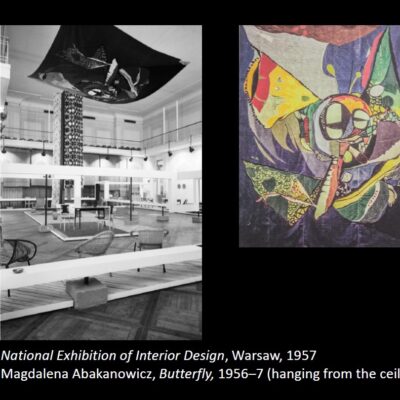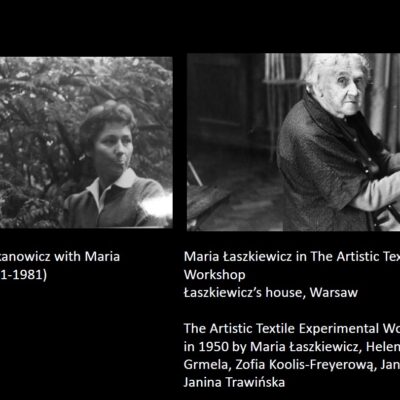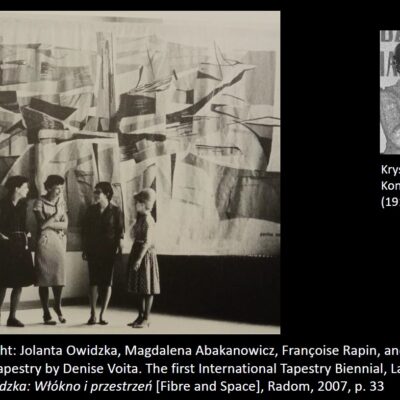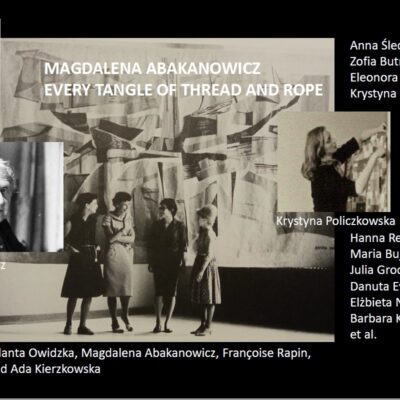Magdalena Abakanowicz as a textile artist in state-socialist Poland
Author: Agata Jakubowska
Between 17 November 2022 and 21 May 2023, Tate Modern in London presented works by Magdalena Abakanowicz (1930—2017), who, in the 1960s and 1970s, created woven forms that challenged the understanding of textile art[1]. Neither the exhibition nor the accompanying catalogue offered any feminist perspective on Abakanowicz’s works and career. It appeared during the two-day symposium devoted to Abakanowicz, organised in London in May 2023, by the Abakanowicz Arts and Culture Charitable Foundation.
Two different approaches emerged in the presentations. One of them aimed at discussing feminist aspects in Abakanowicz’s art. Ewa Majewska (SWPS University of Social Sciences and Humanities, Warsaw) offered a reading of her early works, more of ropes than textiles, and presented them as bringing sensual revolution. Magdalena Moskalewicz (School of the Art Institute of Chicago) turned our attention to abandoning early textile works for ‘masculinist’ figurative sculpture (Abakanowicz did so at the end of the 1970s). Moskalewicz read it as a strategic move of a female artist working in the socialist patriarchy.
The second approach offered a reflection on how to look at Abakanowicz’s art from a feminist perspective thus, it concentrated on the feminist aspects not of her art but of narratives about it. Katy Deepwell (Middlesex University, London) and I discussed the necessity of writing a history where Abakanowicz would be placed next to other women artists. Deepwell offered a broad perspective of transnational comparisons. My paper provided a narrower view as it concentrated on the early stage of Abakanowicz’s career, before the first International Tapestry Biennial in 1962, rightly considered the beginning of her international career.
Textiles were a common choice among women in post-war Poland. Some of them, including Abakanowicz[2], told stories about how they were discouraged from studying sculpture and painting. They probably were, but on the other hand, designing and producing textiles guaranteed an easier way to earn a living. In this post-war period, demand was high, and the Polish state supported textile production. Moreover, textile artists were appreciated as subscribing to the arrangement of new modern life.
In the second half of the 1950s, Abakanowicz was active alongside many other female textile artists in interior design. We find her works at the exhibitions that offered not only an overview of current production in the field of decorative arts but also maquettes of apartments with furnishings. She exhibited her works at the Nationwide Exhibition of Interior Architecture in Warsaw in 1957 and Cracow in 1958. In one of the images from the latter, we can see a fabric designed by her that had a specific function – it separated two spaces of an apartment serving different purposes[3].
Later, at the beginning of the 1960s, Abakanowicz stopped creating fabrics with painting decoration and turned to woven textiles. She became part of a different milieu dominated by women joining the Artistic Textile Experimental Workshop. It was founded in 1950 by several female artists and located in the house of Maria Łaszkiewicz. Her looms survived the war, and she made them available to others. The Workshop aimed at supporting the development of individual artists, offering them access to the equipment (most of them, Abakanowicz included, lacked their studios), but also “an atmosphere of friendly cooperation”[4]. Abakanowicz created her first woven textiles in this studio, including the one for the first Lausanne Biennial (Composition of White Forms, 1962, Central Textile Museum in Łódź).
In one of the images from the Biennial’s opening, we see three Polish women textile artists who came to Lausanne: Magdalena Abakanowicz, Ada Kierzkowska and Jolanta Owidzka. It stresses the fact that Abakanowicz was one of many female textile artists active at that time in Poland, several of whom were proposed and selected to participate in the event. This aspect is hardly present in the narratives of her art as Abakanowicz created – successfully – a myth of herself as a solitary, exceptional artist. She also distanced herself from the early activities in the domain of interior design, presenting her works, also the early ones, as autonomous art. Yet, in reality, she was part of the female-dominated textile art field in the 1950s and 1960s. In no way does it undermine her significance in contemporary textile art and sculpture. Instead, it helps us understand better both the genealogy of her works and the art field in which she actively and pro-actively functioned.
Fragments of Agata Jakubowska’s presentation at the New Encounters with Abakanowicz symposium, May 12-13, 2023, London
[1] The exhibition was organised by Tate Modern in collaboration with the Foundation Toms Pauli at the Musée cantonal des Beaux-Arts de Lausanne/Plateforme 10 and Henie Onstad Art Centre in Høvikodden and will travel to these two places.
[2] Joanna Inglot, The figurative sculpture of Magdalena Abakanowicz: bodies, environments, and myths, Berkeley CA 2004, p. 24
[3] That was a common way of using fabrics in this period always presented as a result of the small square footage of living space available to Polish citizens.
[4] Irena Huml, Współczesna tkanina polska, Warsaw 1898, p. 15.










